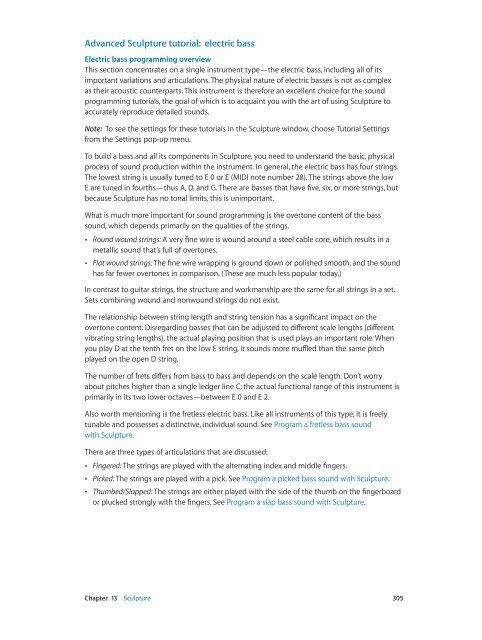Apple MainStage 3 Instruments - MainStage 3 Instruments
Apple MainStage 3 Instruments - MainStage 3 Instruments
Apple MainStage 3 Instruments - MainStage 3 Instruments
Create successful ePaper yourself
Turn your PDF publications into a flip-book with our unique Google optimized e-Paper software.
Advanced Sculpture tutorial: electric bass<br />
Electric bass programming overview<br />
This section concentrates on a single instrument type—the electric bass, including all of its<br />
important variations and articulations. The physical nature of electric basses is not as complex<br />
as their acoustic counterparts. This instrument is therefore an excellent choice for the sound<br />
programming tutorials, the goal of which is to acquaint you with the art of using Sculpture to<br />
accurately reproduce detailed sounds.<br />
Note: To see the settings for these tutorials in the Sculpture window, choose Tutorial Settings<br />
from the Settings pop-up menu.<br />
To build a bass and all its components in Sculpture, you need to understand the basic, physical<br />
process of sound production within the instrument. In general, the electric bass has four strings.<br />
The lowest string is usually tuned to E 0 or E (MIDI note number 28). The strings above the low<br />
E are tuned in fourths—thus A, D, and G. There are basses that have five, six, or more strings, but<br />
because Sculpture has no tonal limits, this is unimportant.<br />
What is much more important for sound programming is the overtone content of the bass<br />
sound, which depends primarily on the qualities of the strings.<br />
••<br />
Round wound strings: A very fine wire is wound around a steel cable core, which results in a<br />
metallic sound that’s full of overtones.<br />
••<br />
Flat wound strings: The fine wire wrapping is ground down or polished smooth, and the sound<br />
has far fewer overtones in comparison. (These are much less popular today.)<br />
In contrast to guitar strings, the structure and workmanship are the same for all strings in a set.<br />
Sets combining wound and nonwound strings do not exist.<br />
The relationship between string length and string tension has a significant impact on the<br />
overtone content. Disregarding basses that can be adjusted to different scale lengths (different<br />
vibrating string lengths), the actual playing position that is used plays an important role. When<br />
you play D at the tenth fret on the low E string, it sounds more muffled than the same pitch<br />
played on the open D string.<br />
The number of frets differs from bass to bass and depends on the scale length. Don’t worry<br />
about pitches higher than a single ledger line C; the actual functional range of this instrument is<br />
primarily in its two lower octaves—between E 0 and E 2.<br />
Also worth mentioning is the fretless electric bass. Like all instruments of this type, it is freely<br />
tunable and possesses a distinctive, individual sound. See Program a fretless bass sound<br />
with Sculpture.<br />
There are three types of articulations that are discussed:<br />
••<br />
Fingered: The strings are played with the alternating index and middle fingers.<br />
••<br />
Picked: The strings are played with a pick. See Program a picked bass sound with Sculpture.<br />
••<br />
Thumbed/Slapped: The strings are either played with the side of the thumb on the fingerboard<br />
or plucked strongly with the fingers. See Program a slap bass sound with Sculpture.<br />
Chapter 13 Sculpture 305
















